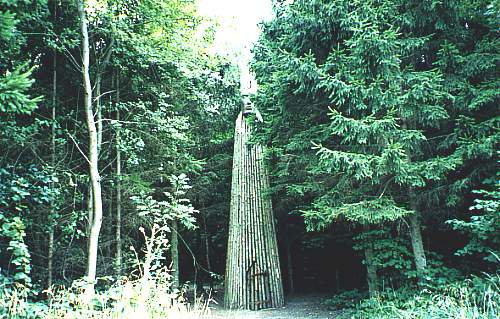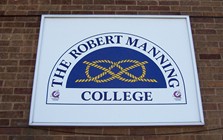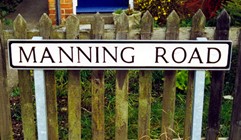|
Robert
Manning
The most noteworthy of all Bourne's citizens was Robert Manning, the Lincolnshire monk who was instrumental in putting the ordinary speech of the English people of his time into a written form that is still recognisable. What we know of him today is largely told in his own writings.
Robert Manning (1264-1338 or 1340), poet and chronicler, is best known as Robert de Brunne from his long residence in Bourne Abbey, founded in 1138 for Arroasian canons, a branch of the Augustinians, and he became their most famous member. His accepted birthplace is Bourne, although some sources suggest that it was Malton in Yorkshire, and he spent some time at Sixhills Priory near Market Rasen before moving to Sempringham Priory, six miles north of Bourne, in 1288 when, according to the rules of the order, he was 24 years old. He then moved to Bourne Abbey in 1303 where he remained for almost forty years and until his death served as Magister, the mediaeval academic rank known in universities today as Master.
It was Robert Manning who gave our English language its present shape because he was the first man to write it as we read it now. He popularised religious and historical material in an early Middle English dialect of great importance in linguistic history although nothing he wrote was ever quite original for he translated the writings of other men into English rhyme from the French but whenever he found a subject on which he was more erudite than the author, he would add his own words to illustrate a point with the result that his judicious omissions and additions made his version far more entertaining than the original. Today, we would call his work doggerel but it was easily understood by the people of his day. The language he used was his own native tongue and as he knew that rhyme was the most easily remembered form of literary output, he therefore used it to give simple, uneducated people knowledge, advice and above all, amusement and he hoped that his writings would provide "solace in their fellowship as they sat together".
His first and best known work was called Handlyng Synne, a translation of Manuel des Pechiez, a poem in bad French by William of Wadington whose writings were far inferior to those of Manning. In it, the results of pride, envy, anger, idleness and other sins are illustrated by sixty-five stories and he discusses a wide variety of subjects which reflect life at that period such as witchcraft, tournaments, games and dress. The preface includes the following lines:
|
For men unlearned I undertook
In English speech to write this book,
For many be of such mannere
That tales and rhymes will gladly hear.
On games and feasts and at the ale
Men love to hear a gossip's tale
That leads perhaps to villainy
Or deadly sin, or dull folly. |
For such men have I made this rhyme
That they may better spend their time.
To all true Christians under sun,
To good and loyal men of Brunn,
And specially all by name
O' the Brotherhood of Sempringhame,
Robert of Brunn now greeteth ye,
And prays for your prosperity. |
The great value of this book is that it gives glimpses into the ways and thoughts of our countrymen 600 years ago and even more, shows us the language then in common use. Robert Manning's influence in standardising the language was very considerable for the East Midlands dialect in which he wrote took the lead of others and eventually became national.
He finished the book in 1303 and he then began to write The Chronicle of England, a new Saxon or English metrical version, the first part an adaption in octosyllabic couplets of the Norman-French translation of Brut d'Angleterre by the Norman poet Robert Wace (1100-1175) and added to it a second part comprising a translation in rhyming alexandrines from a history written in French by the English chronicler Peter of Langtoft. This chronicle has no historical benefit except where it touches the reign of Edward I and so overlaps his own experience. It is a collection of legendary records and so its value is much less than the writings that picture contemporary life but from the point of view of English as it was used, it remains deeply interesting. He finished this work in 1338, on the 200th anniversary of the founding of the abbey.
Robert Manning was a translator and not an original composer but he was the first after Layamon, the Worcestershire monk who lived just before him, to write English in its present form. Geoffrey Chaucer (1343-1400) followed him and then Edmund Spenser (1552-1599), after which the task was easier and he is acknowledged today as the pioneer who created standard English by giving the language of the people who lived here a literary expression.
Little is known about Robert Manning's personal life and there are no records that show whether he was ever married although he wrote kindly of matrimony, saying that there was no solace under heaven comparable with the love of a good woman and he wrote this at a time when it was fashionable to preach the attitudes of St Jerome and St Paul on the desirability of celibacy. We know that he had a good education and spent some time at Cambridge for he speaks of having met Robert the Bruce, the future King of Scotland, there, and his brothers Thomas and Alexander. He also loved the community in which he lived at Bourne Abbey where life and dress were simple.
The canons had three tunics, a cassock, a long white cloak with a hood lined with lamb's wool, two pairs of long stockings reaching above the knees and day and night shoes of red leather. The daily routine was one of work and worship and both followed a set pattern. They rose at midnight for the service of matins after which they were able to slip back to bed until the great bell summoned them for more services. Close to the monastery was the grange or farm producing butter, cheese and honey and craftsmen such as weavers, leather workers and smiths were employed here. The house was run in a very business-like way and made money for profitable causes such as the Crusades but provision was also made for small grants of food or money to assist monks and servants in their old age.
Manning died in 1340, about the time that Geoffrey Chaucer was born and because of its associations with this remarkable man, Bourne has been described as "the cradle of the English language". The old grammar school that stands in the grounds of the Abbey Church was built in 1678 but is believed to have replaced an earlier school dating back to the days when the monastery existed and may have been the very building where Robert de Brunne taught when
magister at the abbey at the beginning of the 14th century.
Historians have judged that Robert Manning was an earnest man, intent on doing good through a rather narrow piety, as might be expected then. But he had a sound knowledge of the people and in his own way was one of the most practical of popular educators. He tried to give the people material for talk and thought and while adopting their own language, he sought to extend its scope. He wrote, as he said, "in simple speech for love of simple men".
|
 |
|
The
woodland sculpture commemorating Robert Manning and the signs
around the town that remember his name.
|
|
 |
 |
Remarkably, there is no memorial or even a plaque to Robert Manning in Bourne Abbey but he is remembered by the Robert Manning
College that has been named after him as is Manning Road that runs through the east of the town. There is also a statue to him of dubious merit, erected with the help of public money in Bourne Woods as part of a woodland sculpture project launched in 1991 by the Forestry Commission in conjunction with the local authorities.
This curious contribution purporting to represent Robert Manning is by the artist John Fortnum and is described by the Forestry Commission as follows: "The sculpture is most impressively approached by a gravelled path from the main track, at the beginning of which a giant footprint gives our first intimation of the sculpture's presence. The path winds through dark pines, emerging at the rear of this gigantic piece. A vertical cone of pine logs soars 30 feet, broken only by the cast concrete head which gazes with remarkable presence across an open area with ponds over the trees beyond towards Sempringham Abbey, the home of Robert's Gilbertine monks. This work with internal ladder and viewing platform, is believed to be the largest work completed by a British sculptor working alone".
The statue has been badly damaged over the years and on one occasion attempts
were made to set it on fire although it is not known whether vandals or art
lovers were to blame. For a man whose life's work has brought honour to our
town, Robert Manning deserves better. See
also A new Manning translation

Go to:
Main Index Villages
Index
|


